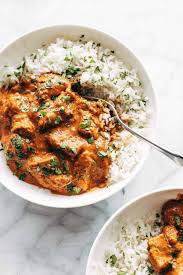Tikka Masala is an iconic dish that represents the harmonious blend of Indian and British culinary traditions. Known for its rich, creamy, and spicy tomato-based sauce, Tikka Masala has captured the hearts of food enthusiasts around the world. This article delves into the origins, ingredients, preparation techniques, and cultural significance of authentic Tikka Masala, providing a comprehensive guide for recreating this beloved dish in your own kitchen.
The Origins of Tikka Masala
The origins of Tikka Masala are shrouded in culinary lore, with competing claims from both India and the United Kingdom. The dish is believed to have been created by South Asian chefs in the UK who wanted to cater to British tastes, blending traditional Indian flavors with a sauce that appealed to the local palate. This fusion gave birth to Tikka Masala, a dish that has since become a staple in Indian restaurants worldwide.
Essential Ingredients for Authentic Tikka Masala
To achieve the authentic Tikka Masala, it is crucial to use high-quality ingredients. Here is a detailed list of what you’ll need:
For the Marinade
Protein: 1 kg (approximately 2.2 lbs) of boneless, skinless chicken thighs or breasts, cut into bite-sized pieces. You can also use paneer, tofu, or vegetables for a vegetarian version.
Yogurt: 1 cup of full-fat yogurt.
Lemon Juice: 2 tablespoons.
Ginger-Garlic Paste: 2 tablespoons of freshly made paste.
Spices: 1 teaspoon each of turmeric powder, red chili powder, ground cumin, and garam masala.
Salt: To taste.
Vegetable Oil: 2 tablespoons.
For the Masala Sauce
Butter: 3 tablespoons.
Oil: 1 tablespoon.
Onions: 2 large onions, finely chopped.
Ginger-Garlic Paste: 2 tablespoons.
Green Chilies: 2, finely chopped (optional, adjust according to spice preference).
Tomatoes: 4 large tomatoes, pureed or 2 cups of tomato puree.
Spices: 1 teaspoon each of ground cumin, ground coriander, turmeric powder, and garam masala.
Paprika: 1 teaspoon (for color and mild flavor).
Heavy Cream: 1 cup.
Sugar: 1 tablespoon (optional, to balance acidity).
Kasuri Methi (Dried Fenugreek Leaves): 1 tablespoon, crushed.
Fresh Cilantro: A handful, finely chopped (for garnish).
Salt: To taste.
Preparation: Step-by-Step Guide
Marinating the Protein
Prepare the Marinade: In a large mixing bowl, combine the yogurt, lemon juice, ginger-garlic paste, turmeric powder, red chili powder, ground cumin, garam masala, and salt. Mix well to form a smooth marinade.
Marinate the Protein: Add the chicken pieces (or paneer, tofu, or vegetables) to the marinade, ensuring they are well-coated. Cover the bowl with plastic wrap and refrigerate for at least 4 hours, preferably overnight. This allows the flavors to penetrate deeply, resulting in tender and flavorful pieces.
Cooking the Tikka
Preheat the Grill or Oven: Preheat your grill or oven to medium-high heat (about 400°F or 200°C). You can also use a stovetop grill pan or a regular skillet if preferred.
Cook the Tikka: Thread the marinated pieces onto skewers if grilling, or place them directly on a baking sheet if using an oven. Grill or bake the pieces until they are cooked through and have a slight char, about 10-15 minutes. If using a stovetop, cook in a pan with a bit of oil over medium-high heat until done.
Preparing the Masala Sauce
Sauté the Onions: In a large skillet or saucepan, heat the butter and oil over medium heat. Add the finely chopped onions and sauté until they turn golden brown.
Add Ginger-Garlic Paste: Stir in the ginger-garlic paste and cook for 2-3 minutes until the raw smell disappears.
Incorporate Green Chilies and Spices: Add the finely chopped green chilies (if using) and stir in the ground cumin, ground coriander, turmeric powder, and paprika. Cook for another 2-3 minutes to allow the spices to release their flavors.
Tomato Puree: Pour in the tomato puree and cook until the mixture thickens and the oil starts to separate from the masala.
Simmer with Cream: Lower the heat and stir in the heavy cream. Let the sauce simmer gently for about 10 minutes, stirring occasionally.
Bringing it All Together
Add Cooked Tikka: Add the grilled or baked tikka pieces to the sauce. Mix well to ensure the pieces are evenly coated with the masala.
Season and Enhance: Crush the dried fenugreek leaves (kasuri methi) between your palms and add them to the curry. Adjust the seasoning with salt and add a tablespoon of sugar if needed to balance the acidity of the tomatoes.
Final Simmer: Let the curry simmer on low heat for another 10 minutes, allowing the flavors to meld beautifully.
Garnishing and Serving
Garnish: Sprinkle freshly chopped cilantro over the tikka masala before serving.
Serve Hot: Serve the tikka masala hot with basmati rice, naan, or roti.
Tips for Perfect Tikka Masala
Quality Ingredients: Using fresh and high-quality ingredients, especially spices, protein, and dairy, can significantly enhance the flavor of the dish.
Marination Time: Allowing the protein to marinate for a longer period results in more tender and flavorful pieces.
Balancing Spices: Adjust the level of spices according to your taste preference. Authentic tikka masala should have a balance of heat, sweetness, and creaminess.
Cooking Method: Grilling the protein before adding it to the sauce imparts a smoky flavor that is characteristic of traditional tikka masala.
Consistency: Adjust the consistency of the sauce by adding water or cream as needed. The sauce should be rich and creamy, but not too thick or too watery.
Variations and Modern Twists
Vegetarian Tikka Masala
For a vegetarian version, substitute the chicken with paneer (Indian cottage cheese), tofu, or mixed vegetables such as cauliflower, bell peppers, and mushrooms. The preparation method remains the same, with the vegetarian ingredients marinated and grilled or baked before being added to the sauce.
Vegan Tikka Masala
To make a vegan tikka masala, replace the chicken with tofu or chickpeas and use coconut milk or cashew cream instead of heavy cream. Ensure that the yogurt used for marinating the tofu or chickpeas is plant-based.
Spicy Tikka Masala
For those who prefer a spicier dish, increase the amount of red chili powder and green chilies in the recipe. You can also add a pinch of cayenne pepper for an extra kick.
Instant Pot Tikka Masala
For a quicker version, you can use an Instant Pot. Sauté the onions, ginger-garlic paste, and spices directly in the Instant Pot using the sauté function. Add the marinated protein, tomato puree, and cream, then pressure cook on high for 10 minutes. Allow the pressure to release naturally before opening the lid and finishing with kasuri methi and garnish.
Nutritional Information
While Tikka Masala is a rich and indulgent dish, it also provides a variety of nutrients:
Protein: The main ingredient (chicken, paneer, tofu, or vegetables) is an excellent source of high-quality protein, essential for muscle growth and repair.
Vitamins and Minerals: The dish contains vitamins like B6 and B12, and minerals such as iron, potassium, and magnesium from the main ingredient and spices.
Healthy Fats: The cream and butter used in the recipe provide essential fatty acids and contribute to the dish’s rich texture.
However, due to its creamy and buttery nature, Tikka Masala should be enjoyed in moderation, especially for those watching their calorie and fat intake.
The Global Influence of Tikka Masala
Tikka Masala has become a global culinary icon, often featured on menus in Indian restaurants worldwide. Its appeal transcends cultural boundaries, making it a favorite among food enthusiasts of various backgrounds. The dish’s rich, creamy sauce and tender, flavorful pieces make it a perfect introduction to Indian cuisine for those new to its diverse flavors.
Tikka Masala in the United Kingdom
In the UK, Tikka Masala is so beloved that it is often regarded as a national dish. It exemplifies the fusion of Indian and British culinary traditions, reflecting the historical and cultural ties between the two countries.
Tikka Masala in the United States
In the United States, Tikka Masala is a popular choice in Indian restaurants and is often featured in food festivals and cooking shows. Its versatility and rich flavors make it a favorite among American food enthusiasts.
Tikka Masala in Australia and Canada
In countries like Australia and Canada, Tikka Masala is equally popular. It is often enjoyed as part of multicultural dining experiences, showcasing the global appeal of Indian cuisine.
Cooking Techniques and Tips from Professional Chefs
To master the art of making Tikka Masala, here are some tips and techniques from professional chefs:
Searing the Protein
Searing the marinated protein in a hot pan before baking or grilling can help lock in the flavors and achieve a nice char on the outside. This technique enhances the overall taste and texture of the tikka.
Using Fresh Spices
Freshly ground spices provide a more vibrant and intense flavor compared to pre-ground spices. Consider using a spice grinder to grind your own cumin, coriander, and other spices just before cooking.
Balancing the Sauce
Achieving the perfect balance of flavors in the sauce is key. Taste the sauce as it simmers and adjust the seasoning, sugar, and cream to ensure it has a harmonious blend of spice, sweetness, and creaminess.
Resting the Curry
Allowing the cooked tikka masala to rest for a few minutes before serving helps the flavors to meld and develop further. This resting period can enhance the overall taste of the dish.
Conclusion
Authentic Tikka Masala is a culinary masterpiece that captures the rich and diverse flavors of Indian cuisine. By following this detailed recipe and incorporating the tips and techniques provided, you can recreate this beloved dish in your own kitchen. Whether you prefer a traditional approach or enjoy experimenting with variations, Tikka Masala offers a delightful dining experience that is sure to impress family and friends.
Embrace the art of cooking Tikka Masala, explore its global appeal, and savor the delicious journey this dish offers. Happy cooking!





